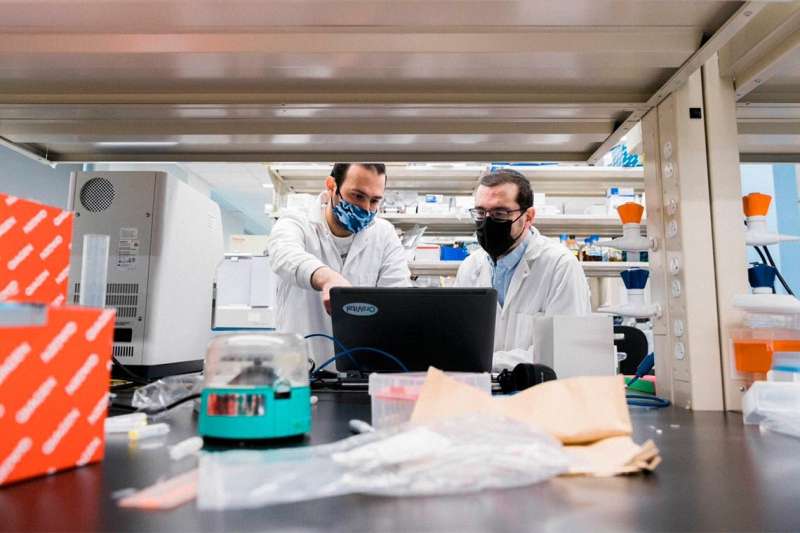This article has been reviewed according to Science X's editorial process and policies. Editors have highlighted the following attributes while ensuring the content's credibility:
fact-checked
peer-reviewed publication
trusted source
proofread
Researchers discover molecule in the mouth that could help eliminate pathogens

Researchers at the University Health Network and University of Toronto have discovered a new biotherapeutic molecule—produced by a strain of oral probiotic bacteria—that kills infectious pathogens while promoting a healthy microbiome.
The findings by Michael Glogauer, dentist-in-chief at the University Health Network and a professor in U of T's Faculty of Dentistry, and Abdelahhad Barbour, a molecular microbiologist and former U of T post-doctoral researcher, were recently published in the Proceedings of the National Academy of Sciences.
Patented as Salivaricin 10 (Sali10), Streptococcus salivarius SALI-10 promises to open the door to an alternative to conventional antibiotic treatments and is a novel solution to prevent infectious diseases.
While conventional antibiotics, mainly isolated from soil-derived microorganisms, generally have a broad spectrum of antimicrobial activity that kills good and bad bacteria alike, Sali10 effectively targets infectious pathogens while also maintaining important oral microbiota.
"Sali10 kills oral pathogens that cause periodontal diseases as well as many multi-drug resistant respiratory pathogens that cause pneumonia," Glogauer says. "Unfortunately, less than three percent of the human population has [their own] S. salivarius that can produce Sali10 in their mouth. We hope to create biotherapeutics in the form of beneficial bacteria with drug-like properties that eventually people can rinse with, or eat foods with, so that their oral microbiome is tipped to a healthy side.
"The S. salivarius bacteria themselves are a drug delivery device due to their probiotics properties which enable them to colonize the mouth and produce and release Salivaricin 10 peptides."
The search for beneficial bacteria
The human microbiome influences our immune system and overall health. Our mouths have the second-largest and most diverse microbiota after the gut, harboring over 700 species of bacteria. With this abundance of microbes within us, there is a rising interest in exploring their health-promoting properties.
As part of their effort to find beneficial bacteria in the mouth, Glogauer and Barbour co-founded a U of T-affiliated startup called Ostia Sciences Inc. in 2020.
"We look for beneficial bacteria in the mouth called commensals with probiotic properties," Glogauer says. "They are the opposite of pathogens and keep us healthy."
This project began by isolating Streptococcus salivarius from healthy people's mouths and observing how these microbes were affecting bacterial pathogens and the innate immune responses. "S. salivarius is [found in] the human oral cavity and the gut, and it co-evolved within the human body over hundreds of thousands of years," Barbour says.
Some specific strains of commensals can produce peptides called lantibiotics (antibiotics that have lanthionine) that can impair pathogens' colonization and promote healthy microbiomes. Lantibiotics produced by S. salivarius are called salivaricins.
"We observed that this previously unidentified structural class of lantibiotics is responsible for many immunomodulatory activities beyond the antimicrobial capacity," Barbour says.
A breakthrough molecule
In fact, the researchers observed that Sali10 molecules were a chemoattractant to neutrophils, which means that they recruited more immune cells to help fight off infections. Sali10 enhanced phagocytosis, the process by which specialized immune cells like neutrophils engulf and break down harmful substances like bacteria and viruses. It was also observed that Sali10 reduced inflammation through the promotion of anti-inflammatory macrophages.
"We wanted to know structurally why these lantibiotic peptides had this incredible multi-functionality. Why was this molecule able to do what it was doing making it superior to other lantibiotics?" Barbour says.
The research team applied structural biology analysis and discovered that Sali10 molecules had a phosphorylation site on the N-terminal region of the peptides. "Sali10 is the first phosphorylated lantibiotic ever discovered. This novel structural feature is responsible for the immunoregulatory function," says Barbour.
He adds that the discovery raises questions about phosphorylated lantibiotics in other human microbiomes and their role in promoting health.
"Having demonstrated the efficacy of Salivaricin 10 in both in vitro and in vivo models, we plan to commence human clinical trials in the near future to establish its safety and efficacy clinically."
More information: Abdelahhad Barbour et al, Discovery of phosphorylated lantibiotics with proimmune activity that regulate the oral microbiome, Proceedings of the National Academy of Sciences (2023). DOI: 10.1073/pnas.2219392120


















